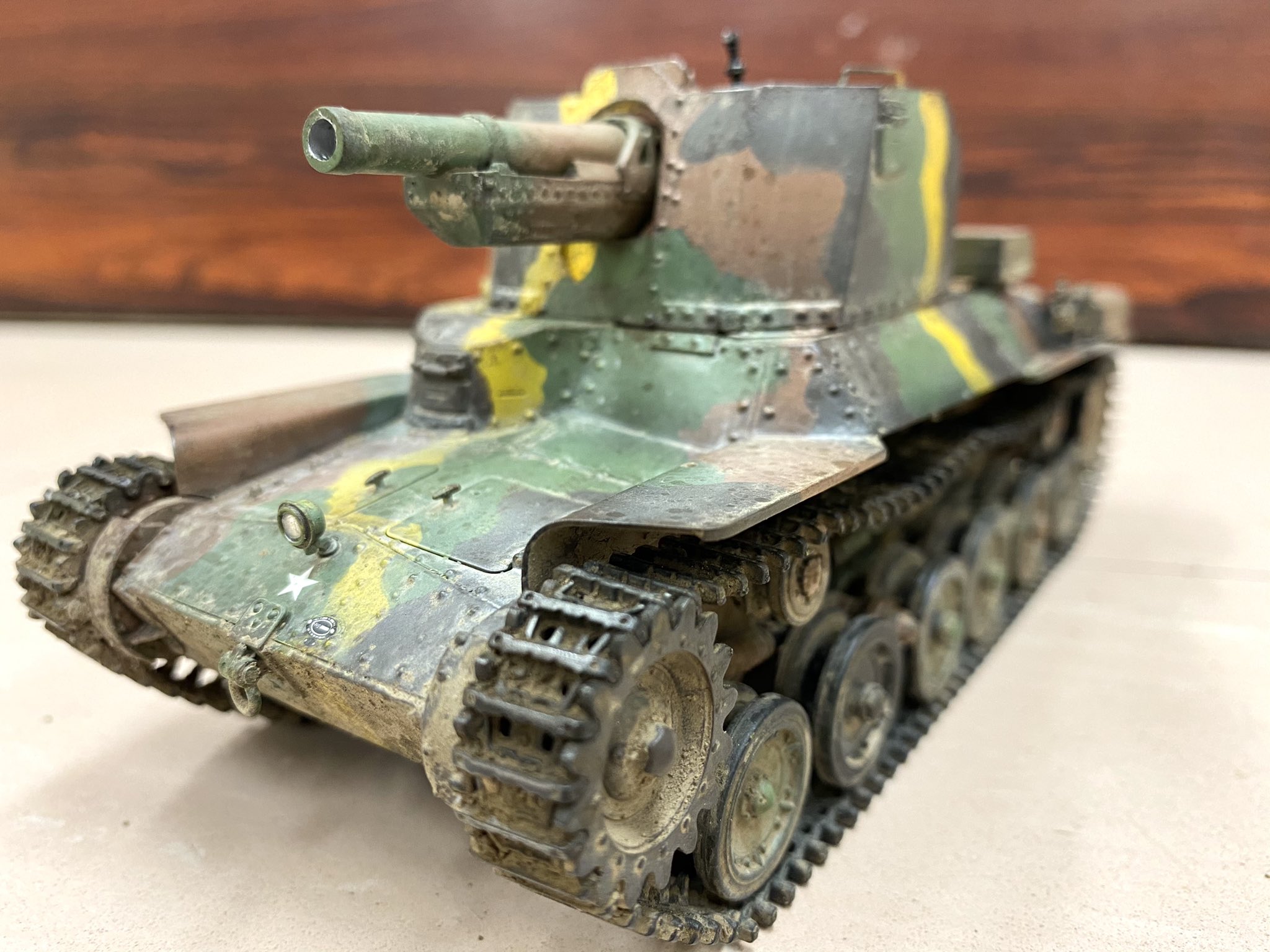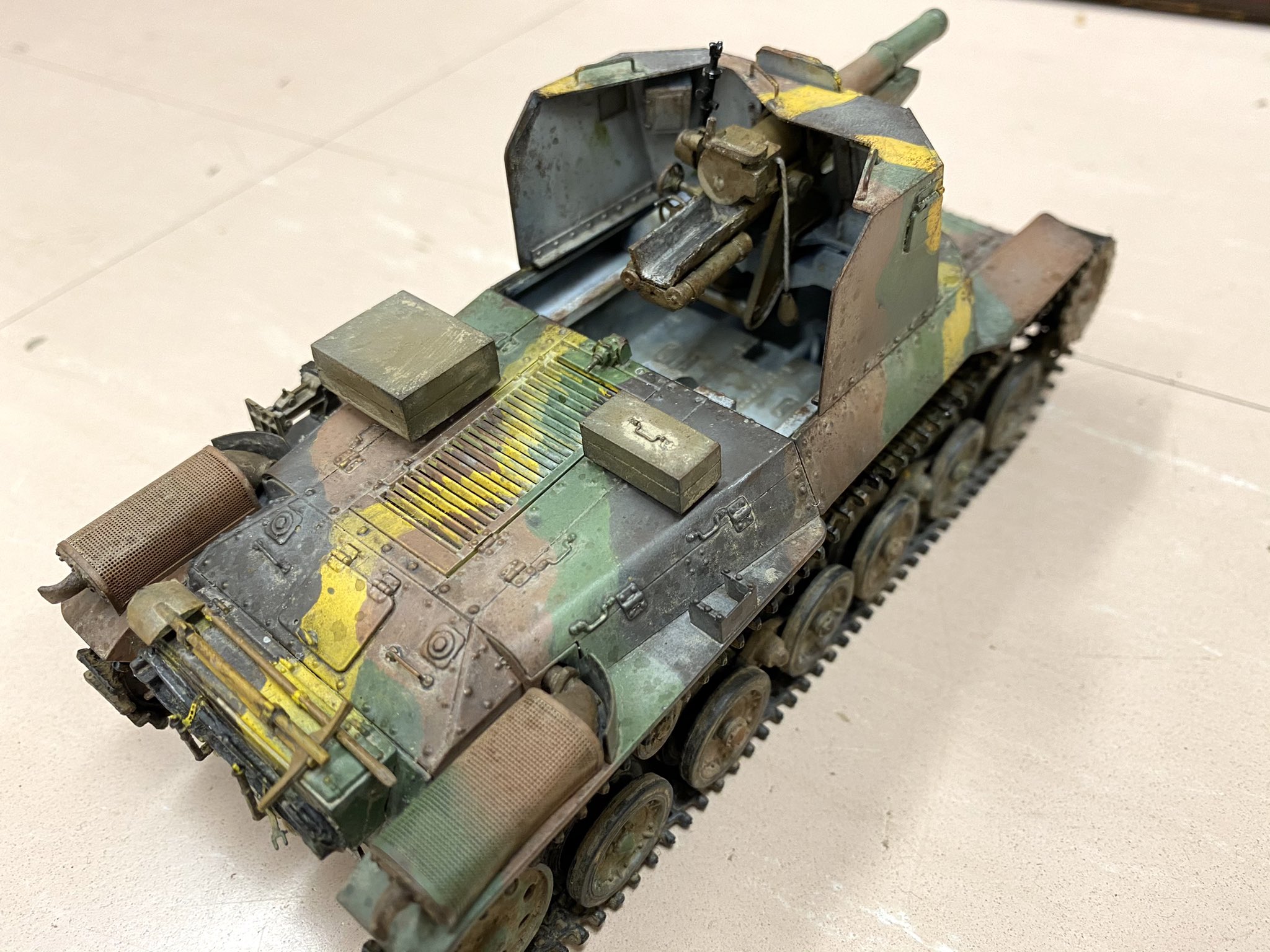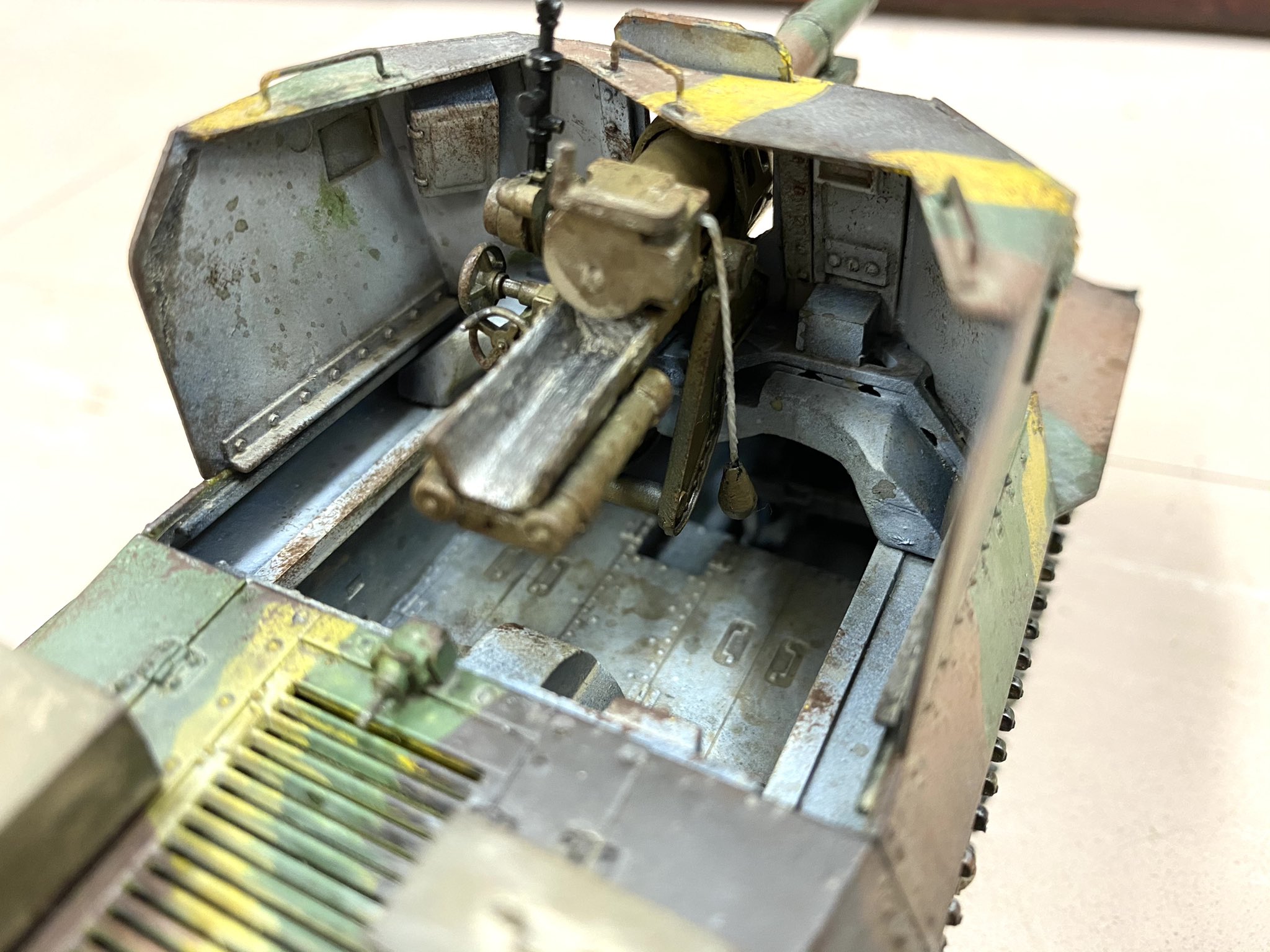- Yes!
- No.
Type 1 Ho-Ni II, Tank Destroyer, Japan, Rank 2
The development of the Type 1 105mm Self-Propelled Gun, known as the Ho-Ni II, was part of Japan’s efforts to bolster its armored capabilities during World War II. With the need for rapid prototyping, Japanese military engineers often drew inspiration from existing German designs. The Ho-Ni II was based on the concept of the German Wespe, utilizing the chassis of the Panzer II tank. Its purpose was to modernize the self-propelled artillery units within tank divisions or brigades using the chassis of the outdated Type 97 Medium Tank. Despite favorable trial results, production of the Ho-Ni II was limited, with only a few units completed. This highlights the challenges Japan faced in matching the industrial output and technological advancements of its adversaries during the conflict.
History
Following the outbreak of war with the United States, the development of armored fighting vehicles (AFVs) by the Japanese military often involved directly referencing existing vehicles from the German army in order to expedite the prototyping process. While towards the end of the Pacific War, there were instances of studying American tanks by the technical side, the Imperial General Staff remained heavily reliant on German designs, with little reference to AFVs from other countries such as the United States or the Soviet Union.
The Type 1 105mm Self-Propelled Gun (Ho-Ni II) was developed based on the concept of the 10.5cm self-propelled howitzer Wespe, which was deployed in the mobile artillery regiments of the German armored divisions and was based on the chassis of the Panzer II tank. The purpose of developing this vehicle, similar to the Type 1 Gun Tank (Ho-Ni I), was to convert the self-propelled artillery units within tank divisions or tank brigades using the chassis of the outdated Type 97 Medium Tank (Chi-Ha) that was becoming obsolete.
The Tank Divisions established in 1942 consisted of two Tank Brigades (each with two Tank Regiments), one Mobile Infantry Regiment, and one Mobile Artillery Regiment, among other units. The Mobile Artillery Regiment comprised one battalion equipped with Type 90 Field Guns (75mm caliber) and two battalions equipped with Type 91 105mm Howitzers.
The Ho-Ni I was a self-propelled version of the Type 90 Field Gun, while the Ho-Ni II was intended to be a self-propelled version of the Type 91 105mm Howitzer. Development of the Type 1 105mm Self-Propelled Gun, codenamed “Ho-Ni II,” began in March 1941, and prototype vehicles were completed by mid-1942, undergoing practical trials at the Army Field Artillery School.
Due to favorable trial results, it was standardized as the “Type 1 105mm Self-Propelled Gun” within the same year. Production of the Ho-Ni II, like the Ho-Ni I, was carried out at the Hitachi Kameari Factory. It is said that a total of 138 units of the Ho-Ni I and Ho-Ni II combined were completed after November 1943, although production of the Ho-Ni II seems to have been very limited.
The chassis of the Ho-Ni II vehicle was largely based on that of the Chi-Ha tank, with the combat compartment enclosed by armored plates, similar to the Ho-Ni I, surrounding the main gun. As direct anti-tank combat was not the primary mission and instead focused on long-range indirect fire, the armor was not as strong as the Ho-Ni I (with a maximum armor thickness of 50mm), with the front of the hull and combat compartment being 25mm thick.
Rear View
Like the Ho-Ni I, the top and rear of the combat compartment were open, providing no protection for the crew from shell fragments resulting from enemy shell or bomb explosions. The main gun mounted was the Type 91 105mm howitzer with a caliber of 105mm and a barrel length of 2,090mm. Therefore, while the Ho-Ni I was a self-propelled field gun, the Ho-Ni II was a self-propelled howitzer.
Front View
Regarding the effectiveness of the Type 91 105mm howitzer, artillery units that went to Burma reported “being able to destroy M4 medium tanks with shells.” However, initially, anti-tank duties were not envisaged. Except for anti-aircraft guns, guns with a caliber of 105mm or more had separate shells and propellant charges/bags, requiring two actions to load and resulting in a relatively reduced rate of fire.
Side View
The barrel was of monobloc construction, with a muzzle ring for reinforcement, and lacked a muzzle brake to reduce recoil during firing. The breech mechanism was of the interrupted screw type, and the gun carriage was slightly modified for vehicle mounting. The muzzle velocity was 454m/s, with a maximum range of 10,800m. The gun elevation angle ranged from -15 to +25 degrees, and the traverse angle was 11 degrees to the left and right. The number of rounds carried is variously reported as 20 or 16 rounds.
Drawings:
Note the shape of gun shields and viewports location are different.
X-ray parts described in Russian
IO5 mm Howitzer Type 9I (I93I)
The Type 91 105mm Howitzer is a light-weight field piece designed for horse-drawn artillery units. Its wooden wheels and light construction make high-speed mobility impossible. The gun itself is of modern design, featuring an interrupted screw-type breech mechanism, a hydropneumatic recoil mechanism, and spring-type equilibrators.
Elevating and traversing handwheels, a range drum, and sight are located to the left of the breech. Calculation of firing data and sighting may be accomplished as with U.S. Artillery. The firing mechanism is a simple percussion hammer pivoted at the base of the breech, actuated by a lanyard.
This howitzer has been encountered frequently and is believed to be a standard weapon in division artillery.
Firing 105mm Type 1 APHE
Source: https://stephentaylorhistorian.files.wordpress.com/2020/09/special-series-34-japanese-tank-and-antitank-warfare.pdf
This gun can fire HEAT munition and achieve a penetration of up to 120mm.
It’s the third column from the right.
With the assistance of @tester188, we’ve obtained additional data regarding this specific HEAT ammunition, as follows:
- Shell weight: 10.910 kg
- Explosive type: TNT + RDX
- Explosive mass: 1.590 kg
- Penetration: 120 mm
- Shell velocity: 337 m/s
Source: 研究事項ニ関スル綴〔内容明細裏面〕 (Page 144).
Regarding armor penetration, with AP rounds, the penetration limits against steel plates were 63mm at a distance of 1500m, 70mm at 1000m, 76mm at 500m, and 83mm at 100m. Additionally, according to information from the former U.S. War Department in August 1945, based on captured specimens of this gun and using Type 1 AP rounds, the penetration values under a 90-degree impact angle were approximately 2.7 inches (about 69mm) at a range of 750 yards (about 685.8m), 2.8 inches (about 71mm) at 500 yards (about 457.2m), and 2.95 inches (about 75mm) at 250 yards (about 228.6m).
(According to combat reports from around 1945 in the Philippines, hits at close range were deemed effective regardless of the hit location. The type of ammunition used in these reports is unspecified.)
For Type 3 High-Explosive Anti-Tank (HEAT) shells, they were capable of penetrating armor of 120mm thickness at a range of 1000m and 80mm thickness at 500m. Approximately 9,000 rounds of Type 3 HEAT shells were produced at the Osaka Army Arsenal Hirakata Manufacturing Plant.
Additional Images
Ho-Ni II in tri-color camouflage. Note the ammunition box on the engine deck.
Gun breach of the Type 91 10.5cm mounted on the Ho-Ni II.
Depressed main gun.
The gun elevation, depression and traverse angles are the same as Ho-Ni I.
-15/20-25 degree low and high field of fire and 11 degree left and right field of fire.
Vehicle Specifications: Type 1 10cm Self-Propelled Gun (Ho-Ni II)
- Dimensions:
- Length: 5.52 meters
- Width: 2.33 meters
- Height: 2.39 meters
- Weight:
- Gross Weight: 16.3 tons
- Crew:
- Crew Members: 5
- Engine:
- Type: Mitsubishi SA12200VD 4-Stroke V12 Air-Cooled Diesel
- Maximum Output: 170hp @ 2,000rpm
- Performance:
- Maximum Speed: 38 km/h
- Range: 200 km
- Armament:
- Main Gun: Type 91 10cm Howitzer (Caliber: 19.9)
- Ammunition: 20 rounds
- Armor:
- Thickness: 12-25 mm
- Penetration Power (Armor-Piercing Shell):
- 1500m: 63mm
- 1000m: 70mm
- 500m: 76mm
- 100m: 83mm
- Penetration Power (High-Explosive Anti-Tank Shell - Type 3 HEAT):
- 1000m: 120mm
- 500m: 80mm
- Additional Information:
- The vehicle’s chassis is based on that of the Chi-Ha tank.
- Armor configuration primarily focuses on indirect aiming and long-range firing rather than direct anti-tank combat.
- Combat compartment lacks full protection against fragments from enemy artillery or bombs.
Type 91 10.5 cm howitzer specifications (Towed howitzer)
- Caliber: 105 mm (4.095 in.)
- Length of bore: 25 calibers
- Weight (overall): 4,360 lbs.
- Length (overall): 17 ft.
- Muzzle velocity: 1,790 ft/sec.
- Max. Range: 11,700 yds.
- Rate of fire: 6/8 rds/min.
- Traverse: 45 degrees
- Elevation: 45 degrees
- Depression: 5 degrees
- Breech block: Interrupted thread
- Wt. of projectile: 34.74 lbs.
- Ammunition: HE and Hollow charge
Scale models


Drawings



Sources
一式十糎自走砲 - Wikipedia
九一式十糎榴弾砲 - Wikipedia
https://combat1.sakura.ne.jp/1SHIKI10.htm
https://www5b.biglobe.ne.jp/~O-NINE/factory09_Making2011.htm
https://www.bulletpicker.com/pdf/CINCPAC-Bulletin-152-45-Japanese-Artillery-Weapons.pdf
https://twitter.com/dodentype3/status/1369308877427183622
Type 1 Ho-Ni II
http://www3.plala.or.jp/takihome/newfolder/Ho-Ni2.html
https://stephentaylorhistorian.files.wordpress.com/2020/09/special-series-34-japanese-tank-and-antitank-warfare.pdf





















